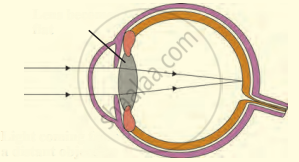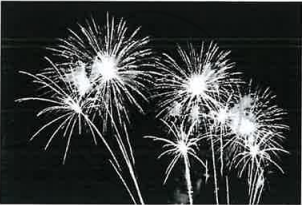Advertisements
Advertisements
प्रश्न
In a relaxed state, the focal length of healthy eyes is _______.
विकल्प
2 cm
2.5 cm
25 cm
5 cm
उत्तर
In a relaxed state, the focal length of healthy eyes is 2 cm.
APPEARS IN
संबंधित प्रश्न
How does the eye regulate the amount of light that falls on the retina?
Which. of the following has normal vision?
(a) Xc Xc
(b) Xc Y
(c) XC Xc
(d) Xc Yc
Draw a labelled sketch of the human eye.
Explain, why a normal eye is not able to see distinctly the objects placed closer than 25 cm, without putting any strain on the eye.
The optical prescription for a pair of spectacles is :
Right eye : −3.50 D
Left eye : −4.00 D
Are these lenses thinner at the middle or at the edges?
Out of rods and cones m the retina of your eye:
which detect colour?
What changes the shape of lens in the eye?
What do the ciliary muscles do when you are focusing on a nearby object?
Give the scientific names of the following parts of the eye:
changes shape to focus a picture on the retina.
How is the amount of light entering the eye controlled?
A person walking in a dark corridor enters into a brightly lit room:
State the effect on the pupil of the eye.
How does this affect the amount of light entering the eye?
There are two types of light-sensitive cells in the human eye:
To what is each type of cell sensitive?
The human eye forms the image of an object at its ______.
After testing the eyes of a child, the optician has prescribed the following lenses for his spectacles:
Left eye : + 2.00 D
Right eye : + 2.25 D
The child is suffering from the defect of vision called:
(a) short-sightedness
(b) long-sightedness
(c) cataract
(d) presbyopia
A person got his eyes tested. The optician's prescription for the spectacles reads:
Left eye: − 3.00 D
Right eye: − 3.50 D
The person is having a defect of vision called:
(a) presbyopia
(b) myopia
(c) astigmatism
(d) hypermetropia
How much is our field of view:
with both eyes open?
Five persons A, B, C, D and E have diabetes, leukaemia, asthma, meningitis and hepatitis, respectively.
Which of these persons cannot donate eyes?
With reference to the functioning of the eye, answer the question that follow:
Name the two structure in the eye responsible for bringing about the change in the shape of the lens.
Choose the correct answer.
Rods are receptor of ______________
Differentiate between:
Yellow spot and Blind spot.
Name the following:
The area where the image is formed but not seen by our eye is termed as.
Name the following:
The region in the eye where the rods and cones are located.
Name the following:
Yellow spot and ciliary muscles are found in.
Name the following:
The part of the eye responsible for change in the size of the pupil.
Mention, if the following statement is True or False
Rods are responsible for vision in the dark
A small hole of changing diameter at the centre of Iris is called _______.
For a normal human eye the near point is at _______.
Write scientific reason.
The movie cannot be enjoyed if seat of a viewer is too close to the screen in the cinema.
The following figure show the change in the shape of the lens while seeing distant and nearby objects. Complete the figures by correctly labelling the diagram.

Why the human eye is compared with camera?
______ of the eye is comparable to the film of a camera.
Describe the parts in the external structure of the eye.
With reference to human eye, answer the following question.
What is blind spot?
Match the following:
| Column - I | Column - II | ||
| 1 | Retina | a | Path way of light |
| 2 | Pupil | b | Far point comes closer |
| 3 | Ciliary muscles | c | near point moves away |
| 4 | Myopia | d | Screen of the eye |
| 5 | Hypermetropoia | e | Power of accomodation |
Match the following:
|
Column - I |
Column - II | ||
| 1 | Retina | a | Path way of light |
| 2 | Pupil | b |
far point comes closer |
| 3 | Ciliary muscles | c |
near point moves away |
| 4 | Myopia | d | Screen of the eye |
| 5 | Hypermetropia | e | Power of accommodation |
Chris was watching the display of fireworks in the sky.

- Trace the path of the light rays using the following terms:
Fovea, Lens, Conjunctiva, Pupil, Cornea. - Name the nerve that carries the impulse for vision to the brain.
Where is the following located?
Yellow spot
Write the main functional activity of the following structure.
Ciliary body and suspensory ligament
